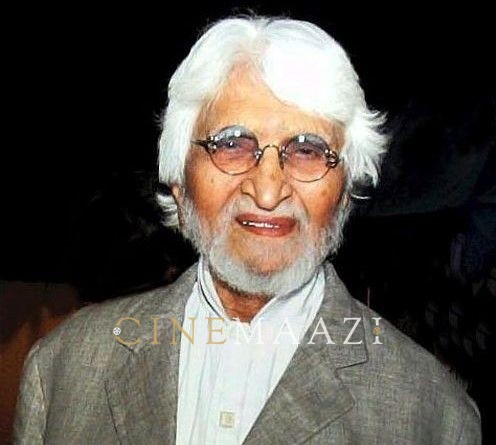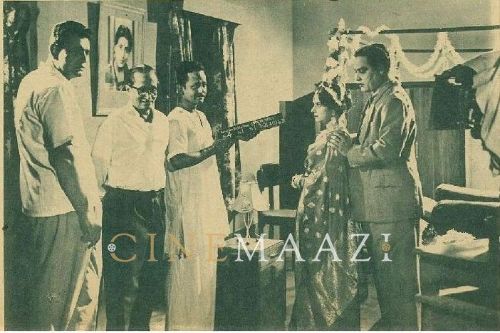M F Husain

Subscribe to read full article
This section is for paid subscribers only. Our subscription is only $37/- for one full year.
You get unlimited access to all paid section and features on the website with this subscription.
Not ready for a full subscription?
You can access this article for $2 , and have it saved to your account for one year.
- Real Name: Maqbool Fida Husain
- Born: 17 September, 1915 (Pandharpur, Bombay Presidency)
- Died: 9 June, 2011 (London, England)
- Primary Cinema: Hindi
- Spouse: Fazila Bibi
- Children: Owais Husain
Among the most celebrated artists of the 20th century, the internationally recognised Maqbool Fida Husain or M F Husain as he was popularly known, was renowned for his vibrant hued narrative paintings rendered in a modified Cubist style. In the mid-1930s, after moving to Bombay (Mumbai), he designed and painted graphic billboard advertisements for Hindi films. He would leave his mark as a printmaker, photographer, and filmmaker. His directorials include Meenaxi: Tale of 3 Cities (2004), Gaja Gamini (2000), and his short subject Through the Eyes of a Painter which was honoured at the Berlin International Film Festival, winning the Golden Bear in 1967. Awarded national honours such as the Padma Bhushan (1973) and the Padma Vibhushan (1991), he eventually earned criticism from some sectors for his treatment of sensitive subject matter, and lived in self-imposed exile from 2006 until his demise.
Born on 17 September, 1915, his interest in art is said to have been sparked while studying calligraphy during his stay at a madrasa. His early years were spent in Indore, post which he attended the Sir Jamsetjee Jeejebhoy School of Art in Mumbai. He began his career as a painter of cinema hoardings. Using freehand drawing and vibrant colour, he depicted Indian subject matter in the style of contemporary European art movements, mainly Cubism.
His first serious work was exhibited in 1947 by the Bombay Art Society, post which he was invited to join five other painters in founding the Progressive Artists Group (PAG), a collective of some of the most iconic artists of India. Formed in 1947 in Bombay, it transformed the modern art scenario of the country. The founding members of PAG were F.N. Souza, K.H. Ara, H.A. Gade, M.F. Husain, S.K. Bakre and S.H. Raza. Challenging the conservative art establishment of their times, the members promoted a progressive style on par with international developments.
Husain went on to achieve fame as the ‘Picasso of India’. He created works that were, in turn, caustic and humorous as well as serious. He worked with a range of diverse themes, usually in series, from Mohandas K. Gandhi, and Mother Teresa, to the Ramayana, the Mahabharata, and the British raj, as well as motifs of Indian urban and rural life. His significant works include Bharatmata or Mother India, Man (1951), Vishwamitra (1973), and Passage Through Human Space, a series of 45 watercolours completed in the mid-1970s.
In the realm of cinema, he first wrote and directed the short Through the Eyes of a Painter in 1967. An experimental film, it presents his images of Rajasthan, through cinema. The artist’s journey through the country side and villages is interspersed with flashes of his sketches which includes a delightful image on the body of a cow. It also received the National Film Award for Best Experimental Film.
His first feature, Gaja Gamini, which translates as woman with the elephant’s gait, released in 2000. Written and directed by Husain, the film is his ode to womanhood and his muse of the time, Madhuri Dixit, who stars as the lead in the film with Shah Rukh Khan and Naseeruddin Shah. The premise was that Gaja Gamini, the embodiment of the Indian spirit, inspires artists of all kinds, interacts with and influences the West, and exists through the ages. While the film was deemed confusing by many, his infatuation with human beauty in every form was apparent. In his lead actress, Madhuri Dixit, he depicted an inspiration for Kalidas’s works as well as the Mona Lisa.
Four years later, his directorial Meenaxi: Tale of 3 Cities was released. Delving into the limitless world of creative endeavours, and vicissitudes in the way of such endeavours, this tale of an artist and his muse left itself open to interpretations and readings by every viewer, much like a painting would. Written by his son, Owais Husain, the film’s cast comprised Tabu, Raghubir Yadav and Nadira Babbar. His most textured work, it was likened to a stunning series of paintings in motion picture, travelling between the old Deccan, Jaisalmer and Prague.
He was also a part-time, casual film critic, seeing interesting metaphors in films. For instance, he drew a sharp analogy with the scene in Danny Boyle’s Slumdog Millionaire (2009), where young Jamal jumps into a pile of excrement to emerge with an unsoiled picture of Amitabh Bachchan. He likened it to the state of the Indian poor, living a desperate existence, and seeking mass entertainment (namely, films) as an escape.
Facing trouble for painting Hindu goddesses as nudes, he faced a series of lawsuits, and also received death threats from Hindu extremists. He thereafter lived in self-imposed exile from 2006, mainly in London and in Dubai, United Arab Emirates.
M F Husain passed away on 9 June, 2011 at the Royal Brompton Hospital, London, United Kingdom. He was 95.
References
https://www.britannica.com/biography/M-F-Husain
https://www.hindustantimes.com/bollywood/mf-husain-his-muses-his-movies/story-MhH0UuseecFiB5yqyCW6xN.html
https://www.artisera.com/blogs/expressions/the-progressive-artists-group-and-its-impact-on-indian-modern-art






.jpg)




